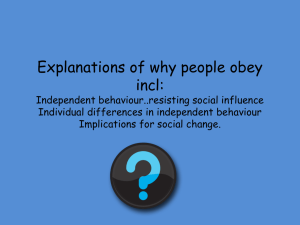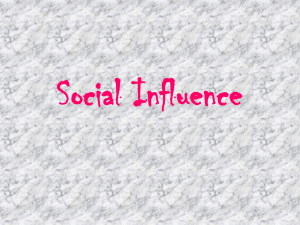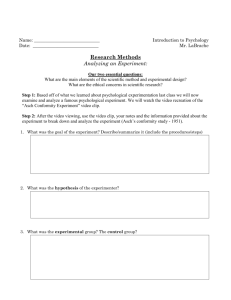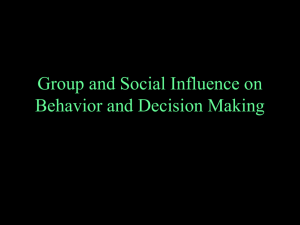Obedience - Beauchamp Psychology
advertisement
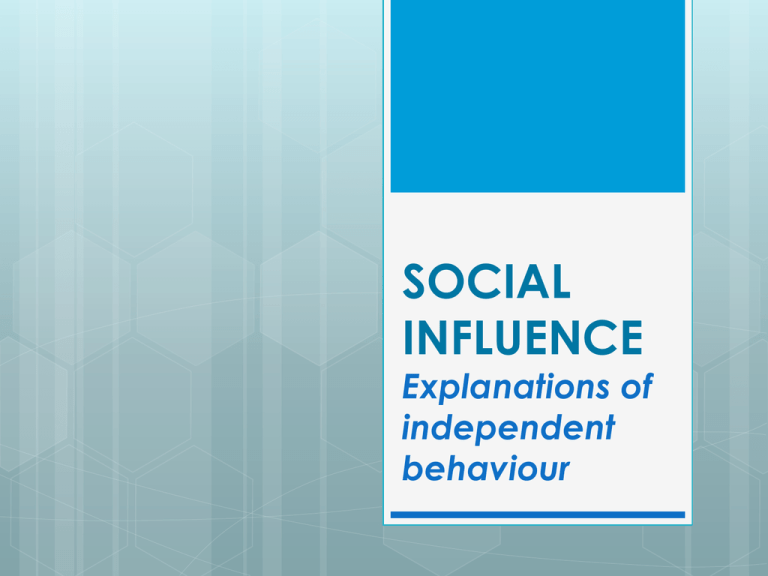
SOCIAL INFLUENCE Explanations of independent behaviour Starter Using the images in your booklet, identify the 4 explanations of why people obey. Write a summary of each explanation in the box provided. 10 minutes, no notes!!! What is independent behaviour? • Research has shown that the majority conform (Asch, 1956) or give in to the demands of authority and obey (Milgram, 1963). • However, there are always those who refuse to comply or obey. This is what we mean by independent behaviour. • Independent behaviour Characteristics??? People displaying independent behaviour: Have control over their own behaviour and decisions. Accept personal responsibility for actions. Stand by morals (what they believe to be right and wrong). Refuse to comply or obey. Why might some people refuse to comply or obey? Personality. Culture. Awareness of situational pressures. Desire for individuation. Why might some people refuse to comply or obey? Personality type – certain characteristics that make up an individual’s personality may make them more likely to refuse to comply/obey. Can anybody link this to what you’ve learnt in the stress topic? The ‘nonconformist’ personality – respond to majority influence with independence, unconcerned about social norms, indifference towards the group norm, predisposed to oppose the norm. Why might some people refuse to comply or obey? Culture – it could be argued that people from individualist cultures are more likely to show independent behaviour as their behaviour centres around their own goals (they are in control). Why might some people refuse to comply or obey? Some people may be more aware of the situational pressures around them and so are better equipped to deal with them (e.g. pressure from other people). Desire for individuation – the desire to maintain a sense of individuality may outweigh the pressures to comply/obey e.g. feel uncomfortable if appear exactly the same as everyone else. Resisting pressures to conform Recap: Asch (1956) Who can tell me something about the study on conformity carried out by Asch? Recap: Asch (1956) Procedures • • • • • • 123 male participants. All but one PT (‘real’ PT) were really confederates. PTs seated around a table. Shown 3 lines of different lengths – asked which of the 3 lines was the same length as a ‘standard’ line. PTs always answered in same order (real PT always last/second to last). Confederates were instructed to give the same incorrect answer on 12/18 trials. Recap: Asch (1956) Findings • • On the 12 critical trials, 36.8% of the responses made by ‘real’ PTs were incorrect. ¼ of ‘real’ PTs never conformed on any of the trials. What finding from the study by Asch can we use as evidence of independent behaviour? ¼ of the ‘real’ PTs never conformed on any of the trials – stuck by what they believed to be right. Unanimity of the majority • • • If the PT was given social support of another real PT or a confederate (i.e. gave the same answer), conformity levels dropped (32% to 5.5%). If ‘dissenter’(other real PT) gave an answer different to the majority and different from the true answer, conformity levels dropped from 32% to 9%. Social support from others who also go against the majority and discrepancies in the answers given can decrease conformity. Resisting pressures to conform Asch – the role of allies Role of informational social influence PT given social support – conformity decreased. The ‘real’ PT uses the other participant (who provides social support) as a source of information, to make an independent assessment of reality. The social support makes the PT feel more confident in their own decision, and in rejecting the majority position. Independent task • Read the study on social support and conformity rates by Allen and Levine (1971) and fill in the missing gaps. • Draw a visual representation of this study on A4 paper. • You have 8 minutes. Resisting pressures to conform Evaluation • • • More willing to maintain independence if moral rather than physical judgements. Physical judgements (i.e. line lengths) – psychological costs associated with abandoning personal position are small compared to the interpersonal benefits achieved by fitting in with the rest of the group. If task involves moral judgements, the cost to one’s personal integrity is much higher so less likely to conform. Independent task Gap fill of exemplar answer in booklet. Resisting pressures to obey Milgram How was independent behaviour shown in Milgram’s research? 12.5% (5 out of 40) participants stopped at 300 volts. Why? When the learner first cried out in pain. Resisting pressures to obey Milgram’s research High proportion (65%) gave maximum 450 volts yet others defied experimenter and withdrew before this point (e.g. 12.5% at 300 volts). Less than 50% obeyed orders in different situational factors – resistance increased when victim could be seen or allies were present. Seeing consequences of actions and having social support are key factors for resistance thus independent behaviour. Independent task • Read the paragraphs on resisting pressures to obey and fill in the missing gaps using your psychological knowledge. Independent task Gap fill of exemplar answer in booklet. Social heroism • • • • • The few who resist authority are ‘heroes’ (Zimbardo, 2007). Heroes – people who are willing to make sacrifices for the good of others in society. Social heroism involves putting oneself at risk in the pursuit of an important principle. It may be costly – lowered social status, arrest, torture, death. E.g. Nelson Mandela – imprisoned for 36 years for his resistance to the government apartheid policies in South Africa. Resisting pressures to obey Evaluation Individual differences in moral reasoning may explain why some people are able to resist orders from an authority figure and others are not. Kohlberg (1969) • Group of Milgram’s volunteers given set of imaginary moral dilemmas. • Found that those who based their decisions on more general moral principles (e.g. importance of justice) were more defiant in the Milgram study (i.e. displayed more independent behaviour).
